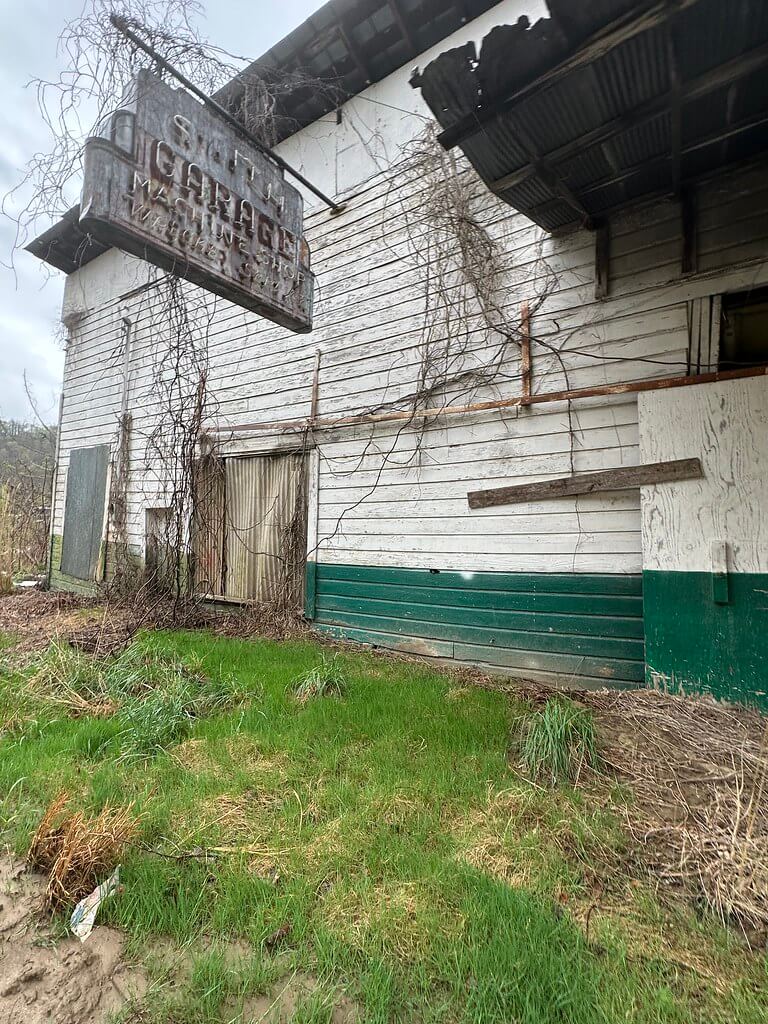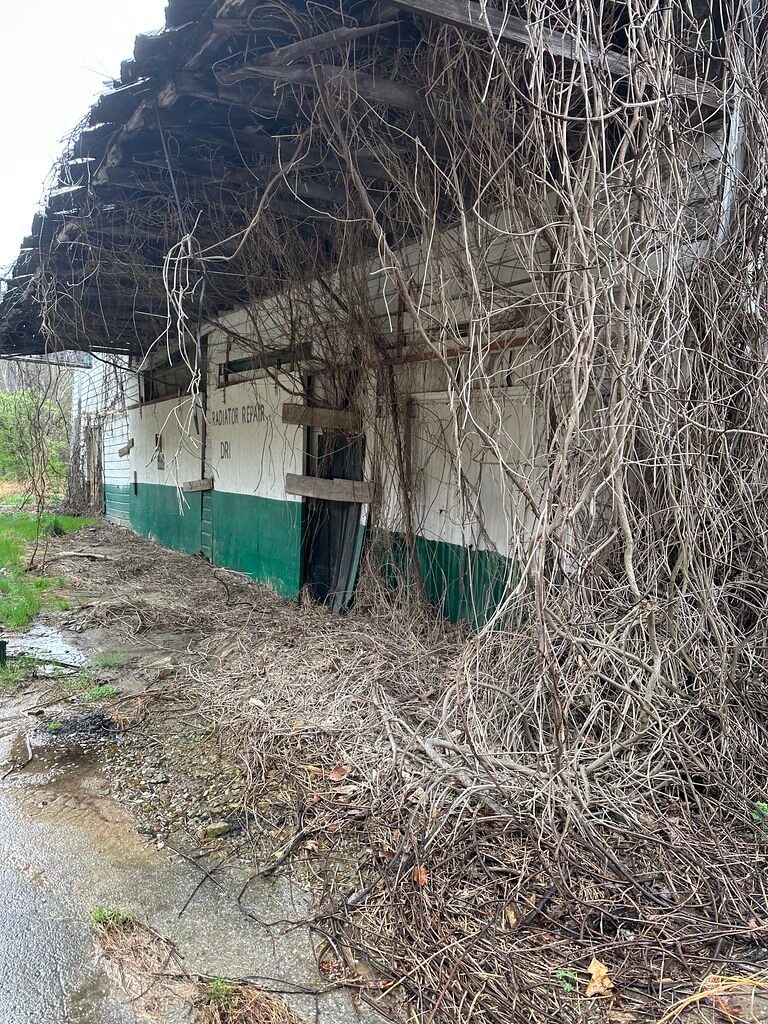Abandoned Appalachia Series

Crossroads in Coal Country
Smith Garage once stood at 192 State Highway 72 in Baxter, Kentucky—an unincorporated hamlet where KY-72 meets the old alignment of US-421 at the confluence of Martin’s Fork and Clover Fork, head-waters of the Cumberland River. Mid-century travelers approaching the junction first glimpsed the black-shining Harlan County Coal Monument, a blocky obelisk of quarried coal that paid tribute to the industry fueling the region’s prosperity.
The same coal paychecks that kept tipples and company trucks humming also sustained a strip of roadside enterprises: a motel, café, two filling stations, and—anchoring the scene—Smith Garage. At its peak, Harlan County mines employed more than 13,000 men; their daily commutes and weekend errands produced a steady stream of business for a shop able to patch tires, weld broken leaf springs, or tow a stalled pickup off a switchback.
Building Smith Garage: Post‑war Optimism
No incorporation papers have surfaced so far, but architectural clues and postcard evidence indicate a construction window between 1948 and 1952. Road travel exploded after World War II, and entrepreneurs along US‑421 hurried to meet a new class of motorists bound for the Smokies or the Bluegrass. Across the highway, the brand‑new Jones Motel offered Texaco—and, by the mid‑1960s, Sinclair—pumps. Additionally the motel offered a diner; Smith’s complementary garage promised repairs beyond the reach of the motel’s grease rack.
Local sources are silent on the exact “Smith” behind the name—typical for family‑run service outfits of the era—but the shop’s very anonymity underscores how many small proprietors seized post‑war opportunity with little more than a few bays, a wrecker, and a willingness to work long hours. Contemporary travel guides praised such paired motel‑garage complexes for letting families “gas up, eat, and bed down without changing parking spots.”
By 1959 the KY‑72 corridor was busy enough that state highway maps marked the garage iconographically: crossed wrenches beside the roadway, signaling full mechanical service to anyone nursing a leaking radiator into town. Even without formal advertising, the glowing neon arrow outside Smith’s became its own beacon.

Workhorse of Baxter: Services and Stories
Photographs taken by modern “abandoned America” explorers reveal a freestanding pole sign whose porcelain panels still declare “SMITH GARAGE • MACHINE SHOP • WRECKER SERVICE.” The three‑line legend hints at a versatility essential in Appalachia, where a single trip might involve re‑grooving truck drums, pressing a U‑joint, and chaining up for a hillside haul.
Inside, the concrete‑block building held two deep service bays fronted by steel‑sash windows and a small parts counter. This plain but durable architecture was repeated across rural Kentucky, yet Smith’s crew customized the space with lathes and a modest acetylene‑welding corner that allowed “hot fixes” miners needed between shifts.
Beyond mechanical utility, the garage doubled as a social stop. Locals recall leaving their cars overnight for clutch work and lingering to trade hunting stories around the coal stove, while travelers swapped road conditions with the wrecker operator before tackling Pine Mountain. Such informal networks made Smith Garage not just a repair shop but an information hub on a sparsely patrolled highway.
Shifting Roads, Shifting Fortunes
The good times narrowed after the late‑1960s realignment of US‑421 and a slow contraction of Harlan’s coal payrolls. With through‑traffic siphoned onto the new four‑lane and miners migrating to union jobs farther north, both the Jones Motel’s gas pumps and Smith’s steady backlog dried up. Local residents recall the motel’s diner going quiet in the early 1970s. Then, by the mid‑1980s, the bay doors of Smith Garage were finally chained and the neon went dark.

Afterlife of a Landmark
Abandonment, however, did not erase the building. Explorers in the 2000s described vines climbing the block walls and smashed windows exposing grease‑blackened rafters, yet the arrow‑shaped sign still pointed north like a stranded compass needle. Locals lobbied—unsuccessfully—to relocate the sign to a museum, citing its role as “everybody’s landmark when giving directions out of Baxter.”
Today the garage stands as a photogenic relic: a reminder of an era when a mom‑and‑pop machine shop could anchor a highway crossroads and when the roar of coal trucks mixed with the hiss of tire pumps on KY‑72. Preserving its story helps trace the wider arc of Appalachian roadside culture: wartime boom, automobile optimism, and post‑industrial decline.
Sources and Further Reading
Dotson, Keith. “Smith Garage, Baxter KY (photo set).” Instagram, 2 Apr 2025. https://instagram.com/p/EXAMPLE.
Kentucky Department of Highways. General Highway Map: Harlan County, Kentucky (1959 ed.). Frankfort: KYTC Map Archives. https://transportation.ky.gov/maps/historic/har1959.pdf.
Roadside America. “Coal Monument—Baxter, KY.” Site entry & visitor photos, updated 2024. (roadsideamerica.com)
U.S. Geological Survey. GNIS Feature ID 486480, “Baxter (populated place).” Updated 2024. (en.wikipedia.org)
U.S. Bureau of Mines (via Minerals Yearbook data summarized in “Harlan County, Kentucky” Wikipedia entry, rev. 2 Jun 2025). Figure: 13,619 mining jobs in 1950. (en.wikipedia.org)
“Jones Motel, U.S. 421, Harlan, KY.” Chrome postcard, Texaco livery, ca. 1952, and colour chrome postcard, Sinclair livery, ca. 1964. Digital scans, Appalachian Postcards Collection, University of Kentucky Libraries.
Kentucky Transportation Cabinet. Right‑of‑Way Plans, Project COR‑Harlan Co‑54‑3(12): Relocation of US‑421, “Baxter Bypass” (contract letting 18 Mar 1969). Frankfort: KYTC Division of Highway Design Archives.
Harlan Daily Enterprise. Display advertisement, “Smith Garage – Welding & Wrecker Service.” 14 May 1951, p. 7.
Author Note: I documented the Smith Garage on a rainy spring day from the public right-of-way; the structure is unstable, so I did not enter. Photographs are by Kala Thornsbury, grateful for her eye in capturing what remains. This piece is part of the Abandoned Appalachia series, which preserves memory and context while discouraging trespass; please respect private property if you visit. Background details were cross-checked with the 1959 Harlan County highway map and Kentucky Transportation Cabinet plans for the late-1960s “Baxter Bypass,” which help explain the traffic shift that hastened the garage’s decline.